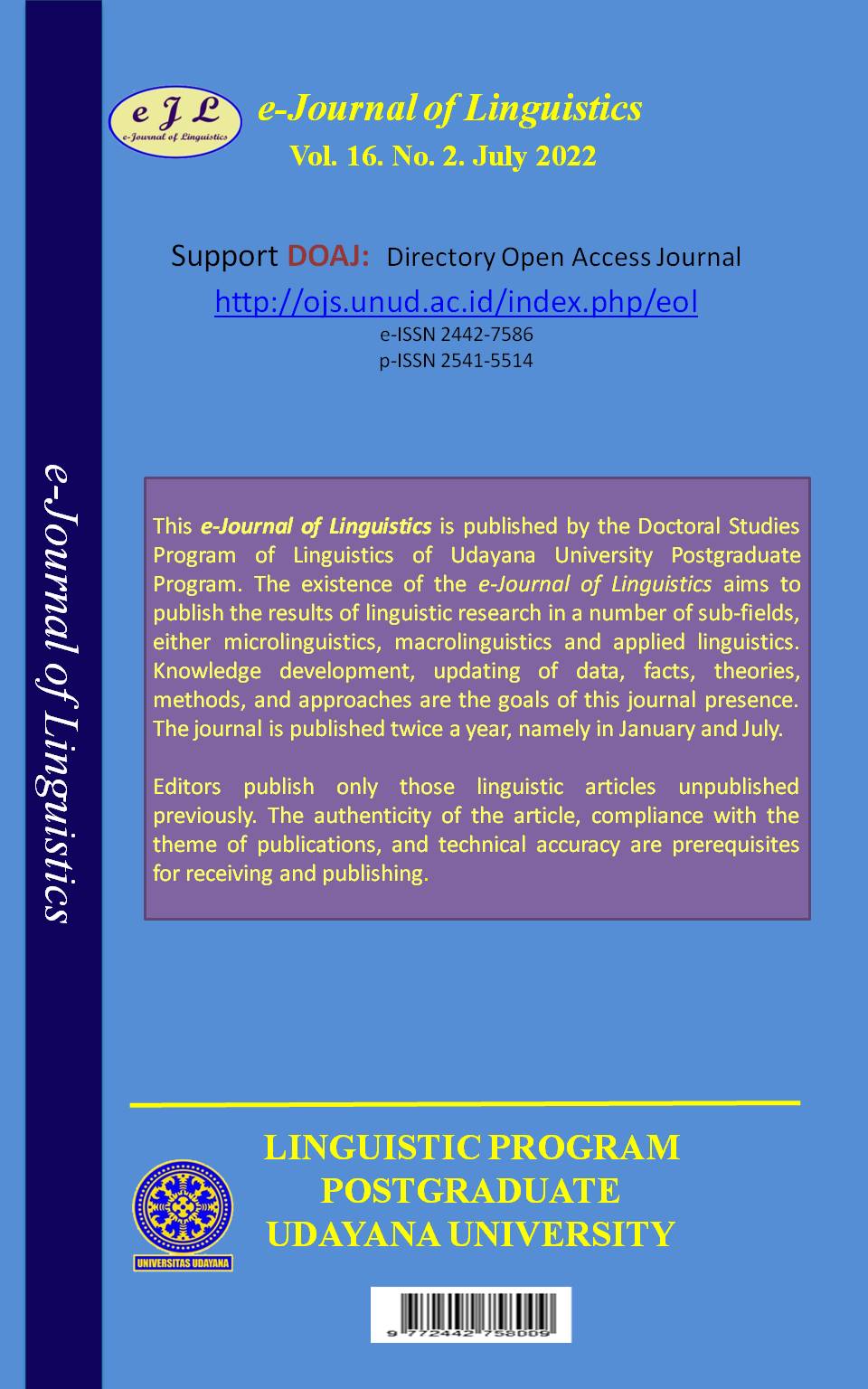en
Abstrak
Nouns are one basic component of the syntactic category of the English language because they can be used as subjects, direct objects, indirect objects, subject complements, object complements, appositives, or adjectives of sentences. Transforming regular nouns from singular to plural forms is comprehensible since the usual patterning is used. Converting irregular nouns from singular to plural forms causes difficulties to non-native learners of English since conversion does not follow the usual patterning. The study examined English second language strategies for teaching irregular plural noun morphological inflection to Grade 8 learners. The researcher used a quantitative research design because the results could be analysed mathematically and statistically. A probability technique was used to randomly sample 25 participants whose ages ranged from 14 to 16 at Ndaedzo Secondary School in Limpopo Province, South Africa. A statistical Package for Social Sciences version 22 was utilised to interpret the findings. Initially, the participants were incompetent in this regard but after utilising the ‘irregular plurals reversi memory game’, and ‘irregular plural nouns in movement game’ strategies, learners’ performance improved remarkably. The research recommends teaching irregular plural noun morphological inflection using the games.
##plugins.generic.usageStats.downloads##
Referensi
Anderton, C. L. & King, E. M. (2016). Promoting multicultural literacies through game-based embodiment: A case study of counsellor education students and the role-playing game oblivion. On the Horizon, 24(1), 44-45.
Aryal. S. (2019). Questionnaire method of data collection. Microbe notes. Available online at: https://microbenotes.com/questionnaire-method-of-data-collection/[Accessed on 8 September 2021].
Audring, J. & Masini, F. (2018). Introduction: Theory and theories in morphology. The Oxford handbook of morphological theory. Oxford University Press.DOI:10.1093/oxfordhb/9780199668984.013.1
Basias, N. & Pollalis, Y. (2018). Quantitative and qualitative research in business & technology: Justifying a suitable research methodology. Review of Integrative Business and Economics Research, 7, pp. 91-105.
Blanton, E. G. (2017). Real-time data as an instructional tool: examining engagement and comprehension (PhD Thesis). Lynchburg, VA 24515, USA: Liberty University.
Case, A. (2019). How to teach irregular plurals. Online available at: https://www.usingenglish.com/teachers/articles/how-to-teach-irregular-plurals.html[Accessed on 22 January 2022].
Conway, D. (1998). An algorithmic approach to English pluralization. In proceedings of Second Annual Perl. Online available at: http://www.csse.monash.edu.au/~damian[Accessed on 20 January 2022].
Creswell, J. W. (2014). Research design: qualitative, quantitative, and mixed methods approach. Thousand Oaks: SAGE Publications.
Drijkoningen, F. (1994). Affixation and Logical Form. Linguistics in the Netherlands, 11(1), pp.25-36.
Forbes, L. K. (2021). The process of play in learning in higher education: A phenomenological study. Journal of Teaching and Learning, 15(1), 57-73.
Geiser, M. S. (2021) Comparing Techniques for Teaching Middle School Science Students to Decode Complex Words Based on Morphology: A Causal Comparative Study. [PhD Dissertation - Northcentral University, California].
Haspelmath, M. (1996).Word-class changing inflection and morphological theory.Yearbook of morphology 1995, edited by Geert Booij and Jaap van Marle. Kluwer, pp.43-66.
Hoang, V. Q. (2021). The differences of individual learners in Second Language Acquisition. International Journal of TESOL & Education, 1(1), 38–46.
James, A. & Nerantzi, C. (2019). The power of play in higher education: Creativity in tertiary learning. Palgrave Macmillan. Journal of Teaching and Learning 15(1), p1.
Jurafksy & Martin. (2017). Morphology: Word formation, FSAs and FSTs. Online available at:https://www.cs.mcgill.ca/~jcheung/teaching/fall-2017/comp550/lectures/lecture2.pdf[Accessed on 17 January 2022].
Isaacs, B. (2018). Understanding the Montessori approach (2nd ed.). London and New York: Routledge Taylor & Francis Group.
Khan, S. I. (2020). Parts of speech. Available online at: www.literaryenglish.com [Accessed on 6 August 2021].
Leithwood, K., Harris, A. & Hopkins, D. (2020). Seven strong claims about successful school leadership revisited. School Leadership & Management, 40(1), 5-22.
Mendívil-Giró, J.L. (2021). Inflection, derivation and compounding: Issues of delimitation. In The Routledge Handbook of Spanish Morphology. Routledge. pp. 55-67.
Merriam-Webster (2021). Noun. Online available at: https://www.merriam-webster.com › dictionary › noun [Accessed on 6 January 2022].
Mohajan, H. K. (2017). Two criteria for good measurements in research: Validity and reliability. UTC Annals of Spiru Haret University, 17(3), 58-82.
Naser, M. (2017). The use of irregular cases by the English and literature students at the University of Tabuk. British Journal of Humanities and Social Sciences 103, 16 (2), 102-110.
Nielsen, P.J. (2016). Inflection and derivation. In Functional Structure in Morphology and the case of non-finite verbs. Brill. pp. 258-289.
Nordquist, R. (2019). 100 irregular plural nouns in English. Online available at:https://www.thoughtco.com/irregular-plural-nouns-in-english-1692634[Accessed on 22 January 2022].
Nordquist, R. (2020) The 9 parts of speech: Definitions and examples. Online available at: https://www.thoughtco.com/part-of-speech-english-grammar-1691590 [Accessed on 22 January 2022].
Pawar, N. (2021). Type of research and type research design. Social research methodology (An overview), pp. 44–57.
Rinvolucri, M. (1984). Grammar Games: Cognitive, affective and drama activities for EFL students. Cambridge: C.U.P.
Schlechtweg, M. & Corbett, G. G. (2021). The duration of word-final -s in English: A comparison of regular-plural and pluralia-tantum nouns. Morphology, pp.1-25.
Silver, E. M. & Martins, C. S. N. (2012). Irregular plurals: an ingenious way of teaching grammar. EDUSER: revista de educacao, 4(2), 12-29.
The Albert Team (2021). Irregular nouns: Definition, examples, & exercises. Online available at https://www.albert.io/blog/irregular-nouns/[Accessed on 29 January 2022].
Tree Valley Academy. (2021). Printable plural nouns worksheets for kids. Online available at: http://www.treevalleyacademy.com[Accessed on 11January 2022].
Verner, S. (2021). 10 fun ways to use Reversi to teach grammar. Online available at: https://busyteacher.org[Accessed on 15 January 2022].
Vygotsky, L. S. (1980). Mind in society: The development of higher psychological processes. Harvard University Press.
Vygotsky, L. S. (1978). Interaction between learning and development. Readings on the development of children, 23(3),34-41.
Wall Street English (2022). Irregular plural noun. Online available at: https://www.wallstreetenglish.com/exercises/irregular-plural-nouns[Accessed on 22 January 202]

This work is licensed under a Creative Commons Attribution 4.0 International License




